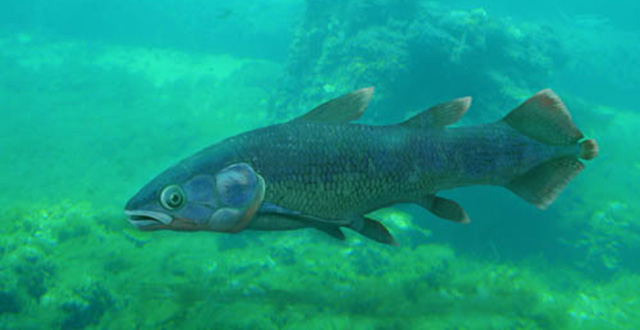An international team of researchers has discovered the fossilized skull of a new species of coelacanth, which is more than 400 million years old, about 17 million years older than previous specimens.

Reconstruction of Euporosteus yunnanensis (Brian Choo)
The new study, published on April 10 in the journal Nature Communications, reports the earliest known fossilized skull of new coelacanth species, called Euporosteus yunnanensis, from the Early Devonian of Yunnan, China, which represents the first record of an anatomically modern coelacanth before the late Middle Devonian.
Among sarcopterygians (lobe-finned fishes and tetrapods), coelacanths are known for their evolutionary conservatism. Epitomized by the legendary living fossil Latimeria, the distinctive body plan of anatomically modern coelacanths can be traced back to fossil forms from the late Middle Devonian. However, the group’s early history is unclear because of an incomplete fossil record.
The new form extends the chronological range of the anatomically modern coelacanths by about 17 million years, and adds to the growing body of evidence pointing to the South China block as the centre for sarcopterygian diversification, from which coelacanth representatives were peculiarly absent until now.
The new materials, consisting of a parietonasal shield and a postparietal shield, were collected in 2009 and 2011 from a yellow sandstone layer of the Posongchong Formation, Yunnan, China.
An important question for studying patterns of the coelacanth evolution is when the anatomically modern coelacanths developed their distinctive body plan. The early fossil record of coelacanths has been scarce, and opinions differ on which sarcopterygian taxon is the closest sister group of coelacanths.
So far, the earliest record of the traditionally defined coelacanth group is one isolated dentary, Eoactinistia, from the Early Devonian of Australia.
“Because of its limited morphological features, Eoactinistia cannot be subjected to a phylogenetic analysis and its position within the coelacanths is unknown”, said Dr. Xiaobo Yu, a study co-author and a professor at Kean University in New Jersey.
Contrary to all expectations for such an early form, Eoactinistia possesses the large dentary sensory pore present in coelacanths from the Carboniferous and younger age, but absent from any of the Middle–Late Devonian forms. The presence of the dentary pore raises the tantalizing possibility that Eoactinistia may be an anatomically modern coelacanth, previously known only from the late Middle Devonian and younger age.
“However, the unknown phylogenetic position of Eoactinistia and the lack of any other Early Devonian coelacanth fossils make it impossible to weigh this possibility against other possibilities, that is, the dentary pore as an independently derived feature that arose twice among coelacanths, or as a primitive feature that was lost in other Devonian forms but then reappeared in later coelacanths”, said Dr. Min Zhu of the Institute of Vertebrate Paleontology and Paleoanthropology, Chinese Academy of Sciences, a lead author of the study.
“The new material resembles Euporosteus eifeliensis from the Middle Devonian of Germany and reveals unique features to justify the erection of a new species,” Dr. Zhu explained. “Phylogenetic analysis places the new form (together with Euporosteus eifeliensis) crownward of Diplocercides or as its sister taxon. The finding expands the existing knowledge of Euporosteus, and represents the first record of an anatomically modern coelacanth before the late Middle Devonian”, “It lends support to the possibility that the dentary pore of Eoactinistia may be a synapomorphy indicating its membership among the anatomically modern coelacanths, previously known only from the late Middle Devonian and younger age”.
“A recent study of the HOX clusters of the Indonesian coelacanth Latimeria menadoensis found features indicating stasis in genome evolution that may be correlated with the stasis in morphological evolution”, Dr. Yu said. “This finding provides a more refined reference point for studying the rapid early diversification and subsequent evolutionary conservatism of the coelacanths”.







